The MFP-3D Origin™ family AFMs mark the intersection of affordability and performance. They feature the high resolution and experimental versatility that you expect from Asylum Research, the AFM technology leader. Their ease of use and budget-friendly prices makes them perfect for researchers new to AFM or anyone looking for a powerful yet affordable AFM.
MFP-3D Origin
Asylum’s most affordable AFM model supports most imaging modes, large samples and a number of accessories.
MFP-3D Origin+
The Origin+ features the same core performance as the Origin but adds support for the whole range of MFP-3D modes and accessories.
The Best Place to Start with AFM
- Tough, robust design is great for busy labs
- Supreme customer support worldwide
- Confidence backed by the Asylum reputation
- Easily the best AFMs at this low price point
- Research-grade performance and features
- Simple to use without sacrificing flexibility
- Complete range of accessories and modes
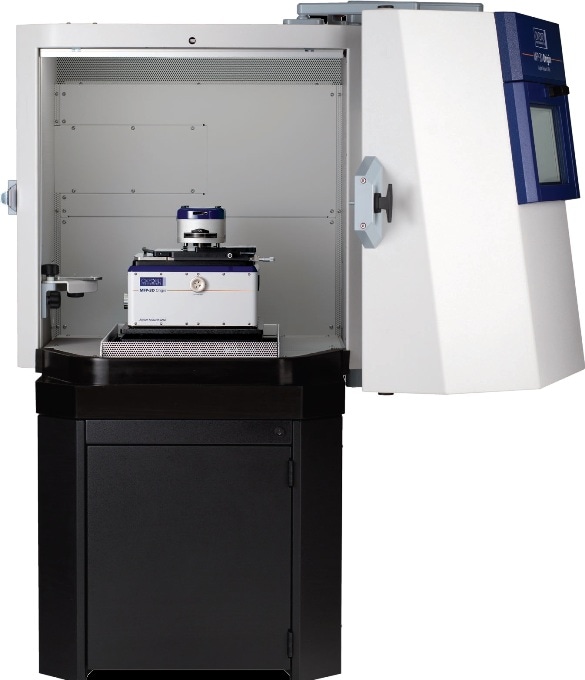
Origin AFMs are Ready for Your Research
High performance and broad capabilities for every research field
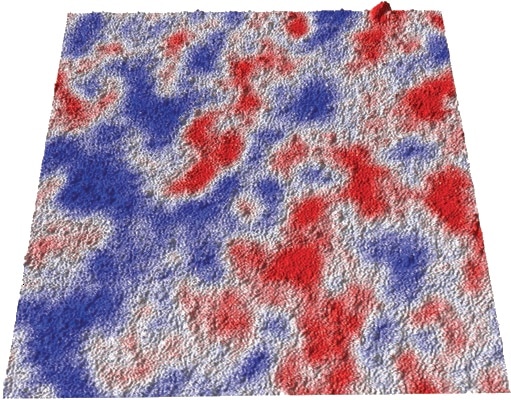
Microgel thin film Surface potential image, 15 μm scan. Courtesy of C.D. Sorrell and L.A. Lyon, Georgia Institute of Technology.
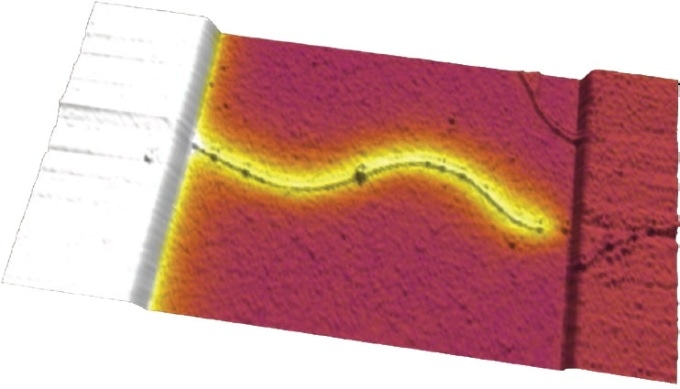
Carbon nanotube attached to an electrode Electrostatic force microscopy (EFM) phase overlaid on topography, 5×2.5 μm scan. Courtesy of Minot Lab, Oregon State University.
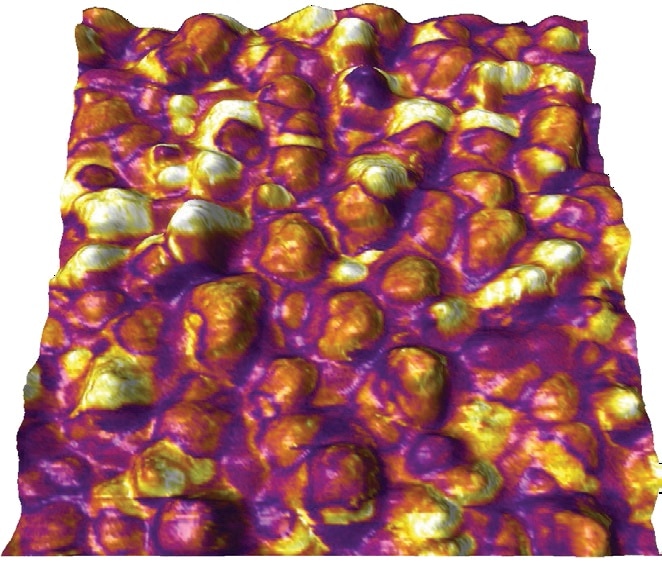
GaFeO3 thin film Piezoresponse force microscopy (PFM) amplitude overlaid on topography, 1.25 μm scan. Sample courtesy of S. Mukherjee, R. Gupta and A. Garg, Indian Institute of Technology, Kanpur.

DNA origami triangles Topography imaged in fluid, ~120 nm per edge, 600 nm scan. Sample courtesy of P.W.K. Rothemund, California Institute of Technology.
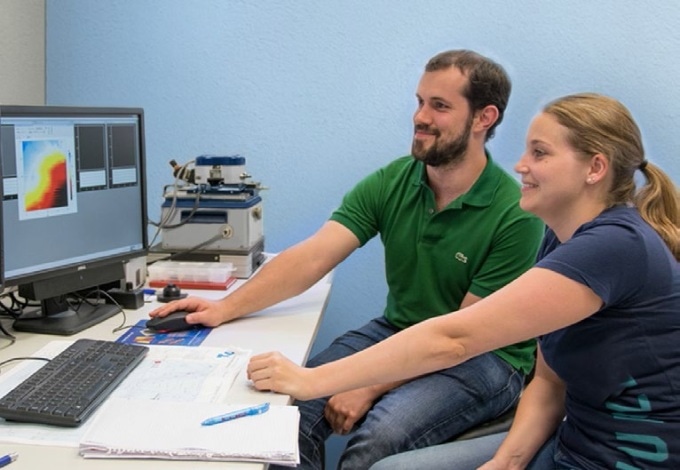
The MFP-3D Origin has proven itself as a top quality research AFM in our lab. Our main project now involves molecular recognition on soft biological samples, which requires low-noise, high-resolution force mapping. We especially appreciate the flexibility that it provides in terms of both the measurements supported and the ease with which we can create custom analysis routines.
Felix Hilpert and Franziska Wild, Lab of Prof. Thorsten Röder, Mannheim University of Applied Sciences
Polymers
- Morphology
- Interface/interphase properties
- Investigation of thermal transitions
- Nanomechanical properties
- Blends, composites and copolymers
Thin Films
- Friction and wear
- Electrical conductivity
- Nanomechanical properties
- Roughness and uniformity
Electronic Devices
- Nanoscale failure analysis
- Dopant profiling
Advanced Materials
- Ceramics and glasses
- Graphene and 2D materials
- Piezo- and ferro-electrics
Energy Materials
- Photovoltaics
- Batteries/electrochemistry
Bioscience and Biophysics
- Food science
- Biomaterials and ecology
- Native membranes and supported lipid bilayers
- Mechanical properties of cells and cell/tissue substrates
- Proteins, nucleic acids, and other biomolecules and molecular self-assemblies
The Highest Performance AFMs in Their Class
AFMs that thrive in busy research groups and multi-user facilities
Modern features and performance that go far beyond all competitors in their class.
High-Resolution Imaging in Both Air and Fluid
- Larger maximum scan size (120 μm) than most AFMs
- Robust mechanical design minimizes noise and drift
Accurate, Lowest-Noise Force Measurements
- Closed-loop Z scanner ensures accurate force-distance measurements and ramp velocities
- Unique design eliminates interference to enable the lowest noise, pN-scale force measurements
Modern Scanner Design Provides Better Measurement Accuracy and Ease of Use
- Origin family AFM scanners use low-noise sensors to measure and correct scan motion in real-time, which both improves measurement accuracy and makes it easy to precisely zoom and offset to regions of interest
- Many similarly-priced AFMs use scanners based on piezo tubes and lack position sensors, which causes scan artifacts and imprecise zooms and offsets
- Origin AFM scanners also use mechanical flexures to keep the scan axes orthogonal and the scan plane flat
Large Stage Makes Sample Navigation Easy
- Stage micrometers allow easy and precise positioning of the sample under the tip using the top-view optics
- Accommodates samples up to 80 mm diameter and up to 10 mm thick (option for up to 27 mm thick)
Engage and Scan - Quickly, Easily and Reliably
- User directly controls the approach, allowing the tip to rapidly be brought close to the surface before piezo feedback gently brings it into contact, preserving delicate tips and samples
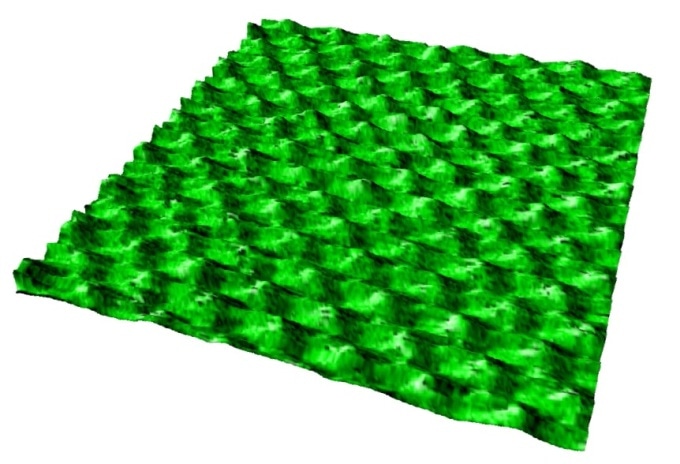
Atomic lattice resolution on a calcite crystal Imaged in liquid in contact mode, 7.5 nm scan.

Mechanical unfolding of titin The exquisite force sensitivity of Asylum AFMs helps unravel the mysteries of protein structure and stability.
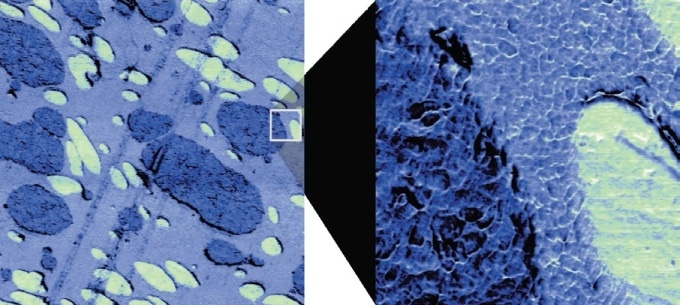
Closed-loop scanner makes it easy to accurately zoom and offset to a region of interest in a single step. Here, a three component polymer blend was imaged. A large overview scan (20 μm) was collected first (left), then a new region was chosen with a single click for a smaller 2 μm scan (right). The modulus data channel is shown, clearly indicating three components. Sample courtesy of Dalia Yablon, ExxonMobil Research and Engineering, Corporate Strategic Research.
Simple Yet Powerful Software
Makes AFM easy for new users while still supporting expert users
Software Tools that Make it Easy to Start Getting Results
- ModeMaster™ configures the software for your choice of measurement type
- GetReal™ automatically calibrates the cantilever sensitivity and spring constant
- SmartStart™ automatically detects and configures system components to get results quickly
Origin AFMs Support a Full Range of Operating Modes
- A few advanced modes for characterizing nanoscale mechanical and electrical properties use optional probe holders, which can be added at any time.
- All basic modes and a number of advanced modes are included at no extra charge on all Origin and Origin+ AFMs.
Automation? Advanced needs? No Problem
- Almost unlimited customization by users is possible within Asylum’s open-source IGOR Pro-based code.
- MacroBuilder™ allows users to effortlessly implement custom routines by just dragging “modules” together to form macros, no coding needed.

ModeMaster enables one-click setup for more than 30 different modes.
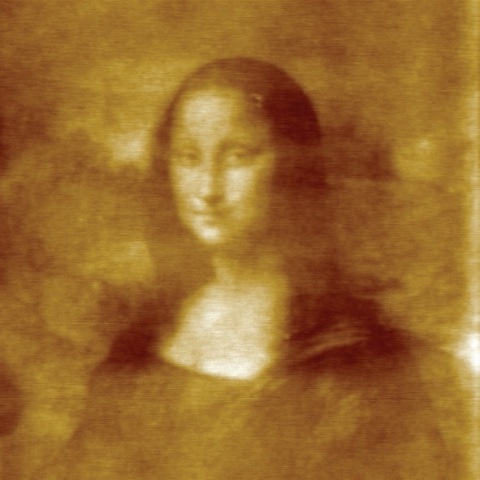
Nanolithography example created by anodic oxidation on silicon, 20 μm scan.
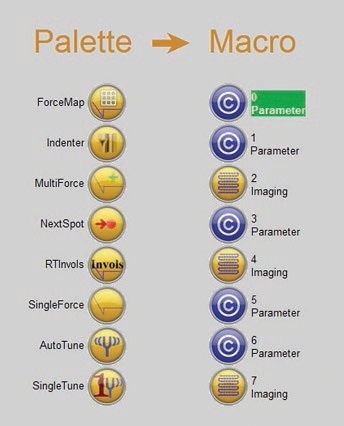
Modes Included on Every Origin and Origin+ AFM
- Contact Mode
- Bimodal Dual AC™
- Dual AC Resonance Tracking (DART)
- Electrostatic Force Microscopy (EFM)
- Force Curve Mode
- Force Mapping Mode (Force Volume)
- Force Modulation
- Fluid Imaging
- Frequency Modulation
- Kelvin Probe Force Microscopy (KPFM)
- Lateral Force Mode (LFM)
- Loss Tangent Imaging
- Magnetic Force Microscopy (MFM)
- Phase Imaging
- Piezoresponse Force Microscopy (PFM)
- Switching Spectroscopy PFM
- Tapping Mode (AC Mode)
- Tapping Mode with Q-control
- Vector PFM
Optional Modes
- AM-FM Viscoelastic Mapping Mode
- Conductive AFM (CAFM) with ORCA™ and Eclipse™ Mode
- iDrive™ (magnetically actuated tapping mode in fluid)
- Scanning Thermal Microscopy (SThM)
- Scanning Tunneling Microscopy (STM)
- Contact Resonance Viscoelastic Mapping Mode (Origin+ only)
- High Voltage PFM (Origin+ only)
- Scanning Microwave Impedance Microscopy (sMIM) (Origin+ only)
Go Beyond Topography — Get Material Properties
Just a Few of the Many Techniques Available on Origin Family AFMs
Mechanical Properties
AM-FM Viscoelastic Mapping Mode
- Tapping mode technique that measures both the elastic storage modulus (E’) and the viscoelastic loss tangent tan δ = E"/E’
- Fast - same speed as regular tapping mode
- Good for samples from 50 kPa to 300 GPa
Contact Resonance Viscoelastic Mapping Mode
- Good for samples from 1 GPa to 300 GPa
- Contact mode technique that measures both storage modulus (E’) and loss modulus (E")
Electrical Properties
Conductive AFM (CAFM)
- Measures DC current from 1 pA to >10 μA
Kelvin Probe Force Microscopy (KPFM)
- Measures sample surface potential and work function
Electrostatic Force Microscopy (EFM)
- Measures electrostatic force gradient
Functional Properties
Piezoresponse Force Microscopy (PFM)
- High-sensitivity and crosstalk-free measurements
- Higher sensitivity is enabled by operating at high voltages (up to ±220 V) and at the tip-sample contact resonance frequency (DART Mode)
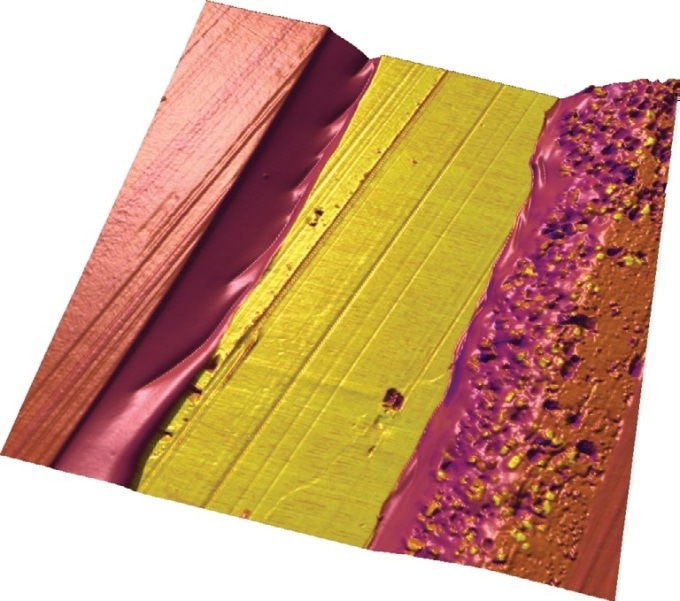
Multi-layered coffee bag cross section imaged using AM-FM Viscoelastic Mapping Mode. Modulus data is shown on 3D topography, 30 μm scan.

Boron nitride and graphene grown on copper film imaged using KPFM. Surface potential data is shown on 3D topography, clearly showing triangular patches of boron nitride and irregular areas of graphene that would have otherwise been obscured by the rough topography of the copper, 50 μm scan. Sample courtesy of N. Wilson, University of Warwick.

Molecular ferroelectric film PFM phase data is shown on 3D topography, 20 μm scan. Image courtesy of A. Eshghinejad and J. Li, University of Washington.
Driving Research to the Next Level
Asylum Research Offers the Widest Range of Innovative Accessories
Accessories that Meet the Practical Needs of Real Research Applications
Many MFP-3D AFM accessories were designed in association with customers in order to provide unique capabilities while maintaining AFM performance and ease of use.
Temperature Control
- BioHeater™ – coverslip-based heater for liquids, up to 80 °C♦
- Petri Dish Heater – heats petri dishes up to 45°C♦
- PolyHeater™ – heat up to 275/400°C (Origin/Origin+)*
- CoolerHeater – Cool or heat between -30 and 120°C♦
External Driving Forces
- Variable Field Module 3 – magnetic fields up to 0.8 T♦
- NanoRack™ – tensile or compressive stress up to 80 N♦
- High Voltage Field – apply up to ±220 V♦
- Probe Station – apply electric signals to samples*
Controlled Gas or Liquid Environments
- Closed Fluid Cell – perfuse gases or liquids*
- Fluid Cell Lite – operate in liquid without perfusion*
- Electrical Closed Cell – controlled gas environment*
- Petri Dish Holder – minimizes evaporation from dish*
- MicroFlow Cell – small volume fluid exchange*
- Humidity Cell – sealed cell with humidity sensor♦
- Electrochemistry Cell – sealed cell with electrodes*
* - Compatible with both MFP-3D Origin and Origin+ AFMs and all other MFP-3D family AFMs
♦ - Compatible with MFP-3D Origin+ AFM and all other MFP-3D family AFMs except MFP-3D Origin

Buckling in hydrogel film immersed in water and heated using the BioHeater accessory, 90 μm scan. Courtesy of D. Chen, University of Massachusetts-Amherst.
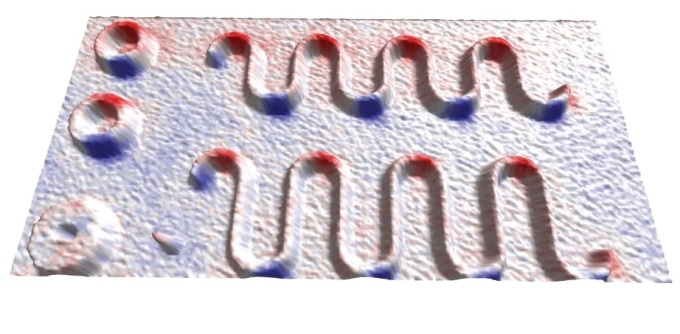
Cobalt nanoribbons imaged using MFM under the influence of an in-plane magnetic field applied with the Variable Field Module. MFM phase data is overlaid on topography, showing the head-to-head (blue) and tail-to-tail (red) domain walls that have been created by the application and removal of the field. Scan size 20×10 μm. Courtesy of J. Bickel and K. Aidala, Mount Holyoke College.
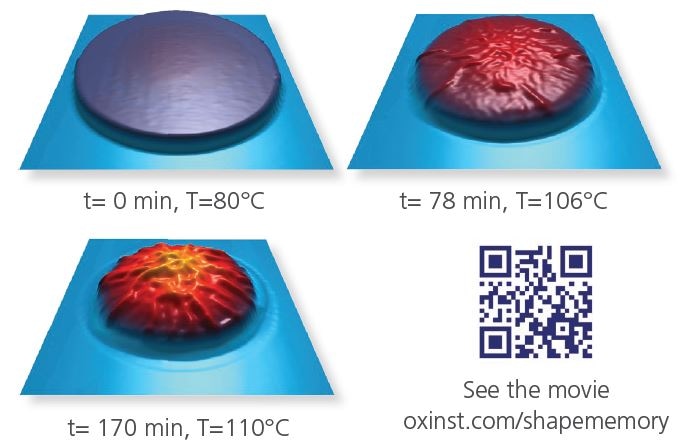
Shape memory polymer microparticle imaged while annealing using the PolyHeater, 12 μm scans. The flattened particle recovers its original shape during annealing. Courtesy of J.P. Killgore, NIST.
Specifications
Precise, Low-Noise Closed-Loop Scanner
- X and Y range 120 μm
- X and Y sensors <0.6 nm noise
- Z range >15 μm (>40 μm option)
- Z sensor <0.25 nm noise
Low-Noise, High-Bandwidth Optical Lever
- Cantilever deflection sensing uses an inverted configuration (incident beam off vertical) to dramatically reduce interference from light reflected by the sample.
- Light source Low-coherence infrared (860 nm) superluminescent diode, FDA/IEC Class 1M (non-hazardous)
- DC detector noise <15 pm
High-Resolution System Performance
- DC height noise <50 pm
- AC height noise <50 pm
(All noise measurements are quoted as the average deviation measured with a 1 kHz bandwidth over a complete 10 seconds at the center of the scanner range. Specifications assumed needed vibration and acoustic isolation in an appropriate laboratory environment.)
Top-View Optics
Probe, IR SLD spot and sample can be viewed via top-down brightfield optics with two selectable fields of view, 240 μm and 720 μm, through a 10× objective.
Sample Stage
- Sample size Up to 80 mm diameter
- Sample thickness Up to 10 mm (up to 27 mm option)
Differences Between Origin and Origin+
The Origin+ model includes Asylum’s ARC2 AFM controller, while the Origin model employs a somewhat simplified Origin AFM controller. This enables the following features on Origin+ that are not available on the Origin:
- External access to various analog inputs and outputs
- "Hamster" controller for direct parameter adjustment
- Additional mode support
- Additional accessory support
All other features and specifications are identical for both.
Acoustic and Vibration Isolation Enclosure
A custom enclosure for vibration and acoustic isolation is included in the standard Origin and Origin+ configurations.
Vibration isolation: A passive mechanical vibration isolation platform is as included standard and does not need compressed air. An optional active electronic vibration isolation platform is available.
Acoustic isolation: Rigid, highly-damped design offers effective isolation of acoustic noise in typical laboratories.
Ergonomics: The door of the enclosure easily swings to the side in order to open and is reversible to accommodate different laboratory floor plans. A smaller access window allows users to reach into the enclosure to make adjustments.
System Upgrade Options
- The Origin is effortlessly upgraded to the Origin+ by upgrading to the ARC2 AFM controller
- Both models can be upgraded all the way to the latest MFP-3D Infinity model for additional imaging modes and even higher performance
Support
- Warranty Full one-year comprehensive warranty
- Support No-charge technical support and expert applications support for the lifespan of the AFM